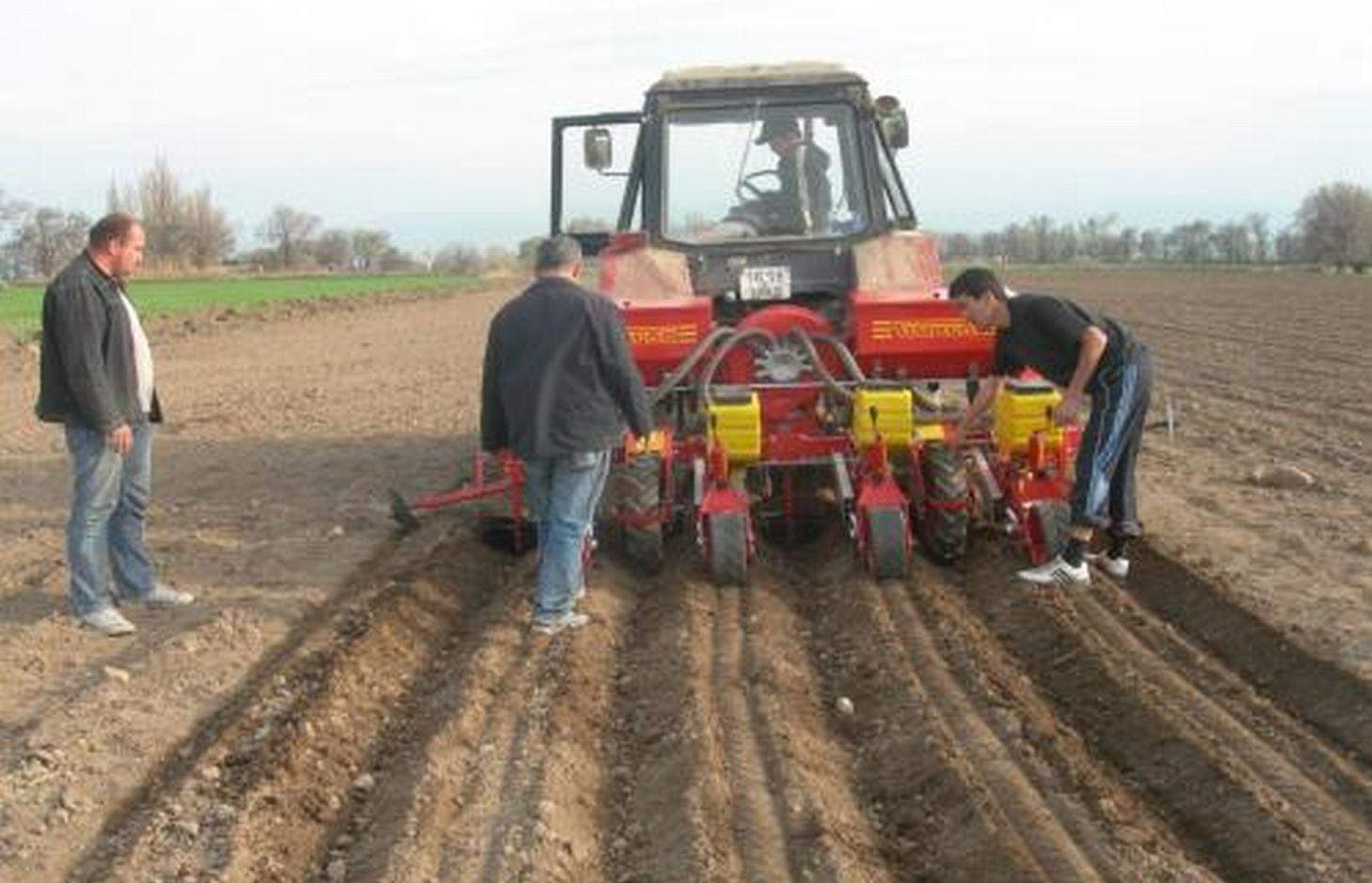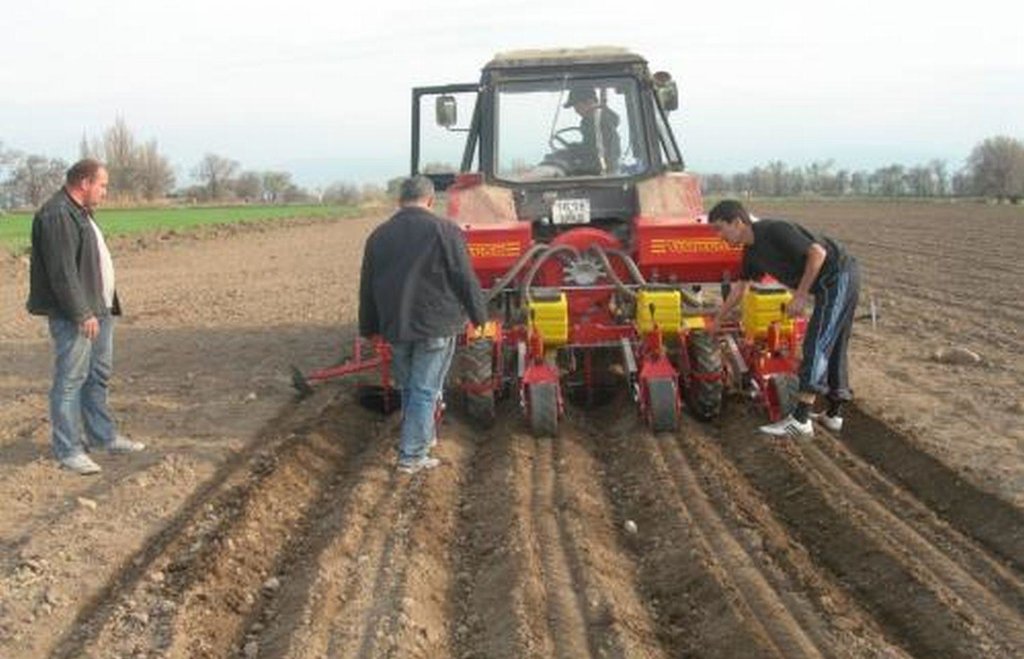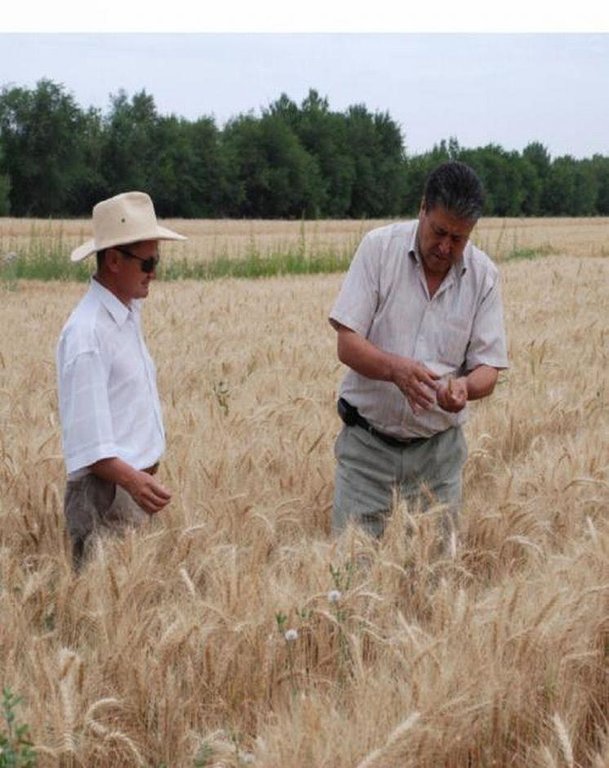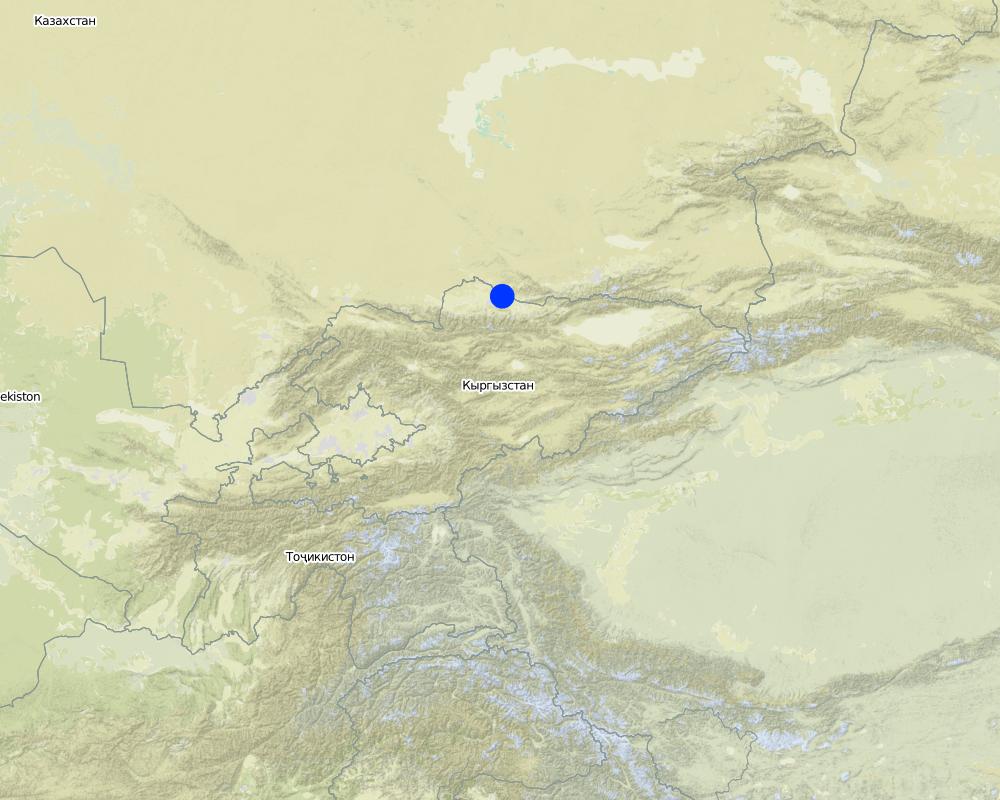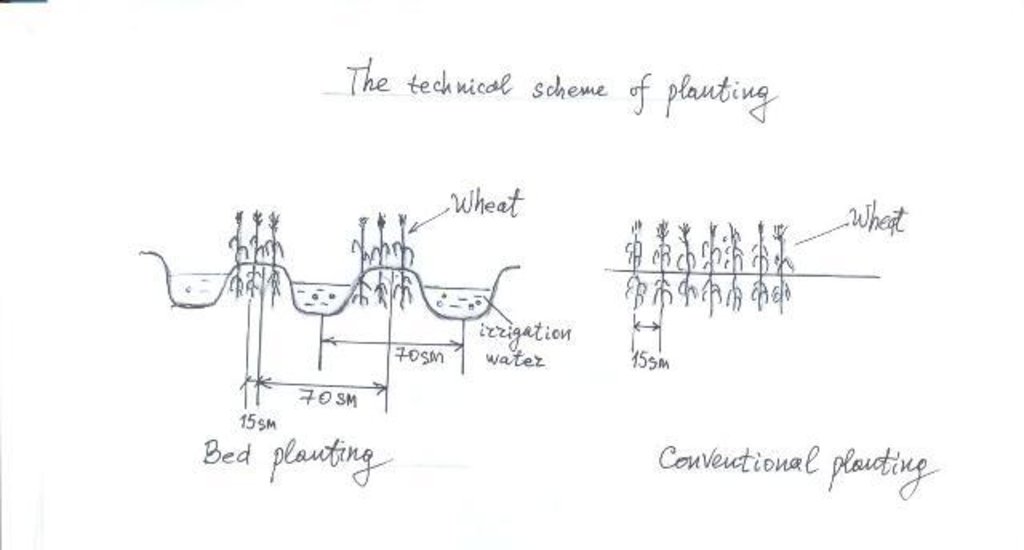The ridge sowing technology (CACILM) [Kyrgyzstan]
- Creation:
- Update:
- Compiler: Abdybek Asanaliev
- Editor: –
- Reviewers: Alexandra Gavilano, Fabian Ottiger
Kyrgyzstan – Central Asian Countries Initiative on Land Management
technologies_1118 - Kyrgyzstan
View sections
Expand all Collapse all1. General information
1.2 Contact details of resource persons and institutions involved in the assessment and documentation of the Technology
Name of project which facilitated the documentation/ evaluation of the Technology (if relevant)
Central Asian Countries Initiative for Land Management (CACILM I)Name of the institution(s) which facilitated the documentation/ evaluation of the Technology (if relevant)
Kyrgyz Agrarian University (Kyrgyz Agrarian University) - Kyrgyzstan1.3 Conditions regarding the use of data documented through WOCAT
When were the data compiled (in the field)?
16/08/2011
The compiler and key resource person(s) accept the conditions regarding the use of data documented through WOCAT:
Yes
2. Description of the SLM Technology
2.1 Short description of the Technology
Definition of the Technology:
The ridge sowing technology utilizes a special seeder, which is operated with special machinery and at the same time cuts the irrigation furrows and sows crops’ seeds on ridges. This method is primarily improved irrigation water use efficiency, reduced water erosion and more importantly lowers the expenses on irrigation water by 30%.
2.2 Detailed description of the Technology
Description:
The ridge sowing technology is applied in CIS countries (Kazakhstan, Kyrgyzstan, Azerbaijan, Tajikistan.) in the production of wheat and other cereals. Kyrgyzstan first applied this technology with the support of the SIDA project “Support to seed development industry in Kyrgyzstan”. Further dissemination of this method was supported by the Seed Growers’ Association of Kyrgyzstan. This technology was utilized in Kyrgyzstan through the use of the Turkish seeder СBP-2,8, which forms ridges, sows and simultaneously cuts furrows to irrigate between the ridges. The ridge sowing technology creates optimal conditions for agricultural crops and provides effective furrow irrigation. This prevents excessive use of irrigation water (saving 25-30%) and irrigation erosion, which happens in the case of using flooding methods on the crop fields using common corn planters. In addition, it prevents the flooding of useful soil micro fauna, as well as saves time. Prior to irrigation or after irrigation, a tractor or agricultural machine can easily go along the irrigation furrows to spray plants with herbicides and pesticides. Ridge sowing of cereals can be implemented almost on all types of grey-brownish, grey, red, yellow soil types with middle and light mechanical composition. In addition to cereals, ridge sowing can be used for growing vegetables and legumes (including potato), as well as industrial and oil crops (sugar beet, rape, soya bean, sesame)
Depending on natural climatic conditions and biological peculiarities of the cultivated varieties, width between the ridges is about 60-70cm. 2-3 rows of seeds can be sown on the ridges with a row spacing of 15cm. Over the course of 3 years, 10 ha of land were sown by using this technology, and the wheat grain yield was not reduced in comparison to the conventional cultivation method using a corn planter. While sowing cereals with such a seeder, it is recommended to cultivate well-bushing varieties. The ridge seeder decreases the seeding rate to a minimum. The seeding rate of cereals is 100-150kg/ha instead of 200-250kg/ha when using the usual sowing method with a classical corn planter and provides additional yield of winter grain wheat up to 5 -8,3 centner/ha. Practice is documented in the frame of CACILM.
Purpose of the Technology: The purpose of this technology is to decrease irrigation erosion and to improve soil moisture content through the use of effective irrigation techniques utilizing irrigation furrows.
Establishment / maintenance activities and inputs: The main cost linked to the introduction of ridge sowing is the purchase of the ridge seeder. The establishment costs of ridge sowing are similar to the ones for conventional sowing methods using corn planters, but in the long term the maintenance costs will be far lower. The utilization of this technology includes the following operations once per vegetation period: plowing (harrowing and leveling), ridge sowing, irrigation and harvesting
Natural / human environment: This technology was implemented on the fields of the Kant local administration of the Kant Rayon in Chui Oblast by 10 land users
2.3 Photos of the Technology
2.5 Country/ region/ locations where the Technology has been applied and which are covered by this assessment
Country:
Kyrgyzstan
Region/ State/ Province:
Kyrgyz Republic
Further specification of location:
Chui oblast, Kant rayon
Map
×2.6 Date of implementation
If precise year is not known, indicate approximate date:
- less than 10 years ago (recently)
2.7 Introduction of the Technology
Specify how the Technology was introduced:
- through land users' innovation
Comments (type of project, etc.):
The technology was introduced in 2009-2010 with the support of SIDA “Support to seed industry development in Kyrgyzstan”.
3. Classification of the SLM Technology
3.2 Current land use type(s) where the Technology is applied

Cropland
- Annual cropping

Grazing land
Extensive grazing land:
- Semi-nomadism/ pastoralism
- Ranching
Main animal species and products:
Ranching: Cows are reared for the production of milk and meat
Semi-nomadism / pastoralism: In summer they are driven to mountain pastures
Grazingland comments: There are sub mountain and mountain pastures in the territory of local self-government bodies
Type of grazing system comments: There are sub mountain and mountain pastures in the territory of local self-government bodies
Comments:
Major land use problems (compiler’s opinion): Frequently repeated droughts, water degradation and salinization of soil due to the irrational use of irrigation water, excess use of seeds
Major land use problems (land users’ perception): A shortage of machinery for soil handling and sowing; high price for the cereal crops’ seeds; outbreaks of pests and diseases; waterlogging due to the clogging of drainage systems
3.3 Further information about land use
Water supply for the land on which the Technology is applied:
- mixed rainfed-irrigated
Comments:
Water supply: полностью орошаемое, полностью орошаемое
Number of growing seasons per year:
- 1
Specify:
Longest growing period in days: 160Longest growing period from month to month: April-September
Livestock density (if relevant):
1-10 LU /km2
3.5 Spread of the Technology
Specify the spread of the Technology:
- evenly spread over an area
If the Technology is evenly spread over an area, indicate approximate area covered:
- < 0.1 km2 (10 ha)
Comments:
Total area covered by the SLM Technology is 0.1 m2.
3.6 SLM measures comprising the Technology

agronomic measures
- A3: Soil surface treatment
Comments:
Type of agronomic measures: furrows (drainage, irrigation)
3.7 Main types of land degradation addressed by the Technology

soil erosion by water
- Wt: loss of topsoil/ surface erosion

biological degradation
- Bl: loss of soil life
Comments:
Main causes of degradation: crop management (annual, perennial, tree/shrub) (Non-observance of crop-rotation; reduction of areas under perennials. Increase in the share of hydrophilic cereals’ varieties. Unwarranted high seeding rates.), disturbance of water cycle (infiltration / runoff) (Extremely high seeding rates while using flooding, which leads to salinization and waterlogging), change of seasonal rainfall (Seasonal drought during the growing season of crops.)
Secondary causes of degradation: droughts (Aerial and soil drought in May and June), education, access to knowledge and support services (Insufficient knowledge on the part of farmers about soil and water conservation)
3.8 Prevention, reduction, or restoration of land degradation
Specify the goal of the Technology with regard to land degradation:
- reduce land degradation
Comments:
Main goals: mitigation / reduction of land degradation
4. Technical specifications, implementation activities, inputs, and costs
4.1 Technical drawing of the Technology
4.2 Technical specifications/ explanations of technical drawing
The illustration shows sowing methods in cross-section. The distance between rows is 15 cm in both methods of sowing. The raised bed planting method is using irrigation water more effectively.
Location: Issyk-Ata region. Chui
Date: 04.10.2011
Technical knowledge required for field staff / advisors: high
Technical knowledge required for land users: moderate
Main technical functions: improvement of topsoil structure (compaction)
Secondary technical functions: increase / maintain water stored in soil
Furrows (drainage, irrigation)
Material/ species: Soil
Quantity/ density: 70 cm
Remarks: Formation of ridges and furrows by turns every 70 cm on a background of a well leveled field
4.3 General information regarding the calculation of inputs and costs
other/ national currency (specify):
KGS (Kyrgyz som)
Indicate exchange rate from USD to local currency (if relevant): 1 USD =:
40.0
Indicate average wage cost of hired labour per day:
11.00
4.4 Establishment activities
| Activity | Type of measure | Timing | |
|---|---|---|---|
| 1. | Purchase of the second hand seeder by the land users | Vegetative |
4.5 Costs and inputs needed for establishment
| Specify input | Unit | Quantity | Costs per Unit | Total costs per input | % of costs borne by land users | |
|---|---|---|---|---|---|---|
| Equipment | Second hand seeder | piece | 1.0 | 3000.0 | 3000.0 | 100.0 |
| Total costs for establishment of the Technology | 3000.0 | |||||
Comments:
Duration of establishment phase: 1 month(s)
Life span of the product: 10 years
4.6 Maintenance/ recurrent activities
| Activity | Type of measure | Timing/ frequency | |
|---|---|---|---|
| 1. | Plowing (careful harrowing and leveling) | Agronomic | Prior to sowing |
| 2. | Ridge sowing | Agronomic | During sowing |
| 3. | Ridge sowing | Agronomic | During sowing |
| 4. | Ridge sowing | Agronomic | During sowing |
4.7 Costs and inputs needed for maintenance/ recurrent activities (per year)
| Specify input | Unit | Quantity | Costs per Unit | Total costs per input | % of costs borne by land users | |
|---|---|---|---|---|---|---|
| Labour | Plowing (careful harrowing and leveling) | person/days | 8.0 | 3.4375 | 27.5 | 100.0 |
| Labour | Irrigation | person/days | 8.0 | 0.9375 | 7.5 | 100.0 |
| Equipment | Machine use for irrigation | ha | 1.0 | 10.0 | 10.0 | 100.0 |
| Equipment | Machine use for harvesting | ha | 1.0 | 10.0 | 10.0 | 100.0 |
| Plant material | Seeds (150kg/ha) | ha | 1.0 | 37.5 | 37.5 | 100.0 |
| Fertilizers and biocides | Fertilizer (100kg/ha) | ha | 1.0 | 50.0 | 50.0 | 100.0 |
| Total costs for maintenance of the Technology | 142.5 | |||||
Comments:
Machinery/ tools: СBP- 2,8
Maintenance costs for ridge sowing are calculated per 1 ha taking into account prices for 2009 and 2010.
4.8 Most important factors affecting the costs
Describe the most determinate factors affecting the costs:
The technology’s cost depends on the physical state of the soil (degree of moisture, field slope, mechanical composition of soil), seed costs and fuel to be used for the machinery
5. Natural and human environment
5.1 Climate
Annual rainfall
- < 250 mm
- 251-500 mm
- 501-750 mm
- 751-1,000 mm
- 1,001-1,500 mm
- 1,501-2,000 mm
- 2,001-3,000 mm
- 3,001-4,000 mm
- > 4,000 mm
Agro-climatic zone
- semi-arid
Thermal climate class: temperate
5.2 Topography
Slopes on average:
- flat (0-2%)
- gentle (3-5%)
- moderate (6-10%)
- rolling (11-15%)
- hilly (16-30%)
- steep (31-60%)
- very steep (>60%)
Landforms:
- plateau/plains
- ridges
- mountain slopes
- hill slopes
- footslopes
- valley floors
Altitudinal zone:
- 0-100 m a.s.l.
- 101-500 m a.s.l.
- 501-1,000 m a.s.l.
- 1,001-1,500 m a.s.l.
- 1,501-2,000 m a.s.l.
- 2,001-2,500 m a.s.l.
- 2,501-3,000 m a.s.l.
- 3,001-4,000 m a.s.l.
- > 4,000 m a.s.l.
5.3 Soils
Soil depth on average:
- very shallow (0-20 cm)
- shallow (21-50 cm)
- moderately deep (51-80 cm)
- deep (81-120 cm)
- very deep (> 120 cm)
Soil texture (topsoil):
- medium (loamy, silty)
Topsoil organic matter:
- medium (1-3%)
5.4 Water availability and quality
Ground water table:
< 5 m
Availability of surface water:
good
Water quality (untreated):
good drinking water
5.5 Biodiversity
Species diversity:
- medium
5.6 Characteristics of land users applying the Technology
Off-farm income:
- less than 10% of all income
Relative level of wealth:
- average
- rich
Individuals or groups:
- individual/ household
Level of mechanization:
- mechanized/ motorized
Gender:
- men
Indicate other relevant characteristics of the land users:
Land users applying the Technology are mainly common / average land users
Population density: 10-50 persons/km2
Annual population growth: 1% - 2%
10% of the land users are rich and own 40% of the land.
70% of the land users are average wealthy and own 50% of the land.
20% of the land users are poor and own 10% of the land.
Off-farm income specification: During their free time, these farmers can use SLM on the fields of other farmers on a fee paying basis. Some farmers have shops for the sale of agrochemicals
Market orientation of production system: mixed (subsistence/ commercial, commercial/ market, commercial/ market
5.7 Average area of land owned or leased by land users applying the Technology
- < 0.5 ha
- 0.5-1 ha
- 1-2 ha
- 2-5 ha
- 5-15 ha
- 15-50 ha
- 50-100 ha
- 100-500 ha
- 500-1,000 ha
- 1,000-10,000 ha
- > 10,000 ha
Is this considered small-, medium- or large-scale (referring to local context)?
- medium-scale
Comments:
Average area of land owned or leased by land users applying the Technology: 0.5-1 ha, 5-15 ha, 15-50 ha
5.8 Land ownership, land use rights, and water use rights
Land ownership:
- individual, not titled
Land use rights:
- individual
Water use rights:
- communal (organized)
5.9 Access to services and infrastructure
health:
- poor
- moderate
- good
education:
- poor
- moderate
- good
technical assistance:
- poor
- moderate
- good
employment (e.g. off-farm):
- poor
- moderate
- good
markets:
- poor
- moderate
- good
energy:
- poor
- moderate
- good
roads and transport:
- poor
- moderate
- good
drinking water and sanitation:
- poor
- moderate
- good
financial services:
- poor
- moderate
- good
6. Impacts and concluding statements
6.1 On-site impacts the Technology has shown
Socio-economic impacts
Production
crop production
Quantity before SLM:
0
Quantity after SLM:
5-8 centner/ha
land management
Water availability and quality
demand for irrigation water
Income and costs
expenses on agricultural inputs
farm income
economic disparities
Socio-cultural impacts
food security/ self-sufficiency
recreational opportunities
Quantity before SLM:
2
Quantity after SLM:
3
SLM/ land degradation knowledge
Quantity before SLM:
0
Quantity after SLM:
50
Ecological impacts
Soil
soil moisture
soil cover
Quantity after SLM:
10
6.3 Exposure and sensitivity of the Technology to gradual climate change and climate-related extremes/ disasters (as perceived by land users)
Gradual climate change
Gradual climate change
| Season | Type of climatic change/ extreme | How does the Technology cope with it? | |
|---|---|---|---|
| annual temperature | increase | well |
Climate-related extremes (disasters)
Meteorological disasters
| How does the Technology cope with it? | |
|---|---|
| local rainstorm | not well |
| local windstorm | not known |
Climatological disasters
| How does the Technology cope with it? | |
|---|---|
| drought | not well |
Hydrological disasters
| How does the Technology cope with it? | |
|---|---|
| general (river) flood | not known |
Other climate-related consequences
Other climate-related consequences
| How does the Technology cope with it? | |
|---|---|
| reduced growing period | well |
6.4 Cost-benefit analysis
How do the benefits compare with the establishment costs (from land users’ perspective)?
Short-term returns:
neutral/ balanced
Long-term returns:
very positive
How do the benefits compare with the maintenance/ recurrent costs (from land users' perspective)?
Short-term returns:
slightly positive
Long-term returns:
positive
6.5 Adoption of the Technology
Comments:
5 land user families have adopted the Technology with external material support
10 land user families have adopted the Technology without any external material support
There is a moderate trend towards spontaneous adoption of the Technology
Comments on adoption trend: The adoption trend is present due to obvious economic and ecological benefits, as well as an increase of awareness among the farmers, who participated in the workshop. Together with the rayon agricultural department, Ministry of Agriculture, Rural Advisory Service and SIDA, the project was carried out the in field with the participation of interested farmers from Kant, Sokuluk and Belovodsk rayons.
6.7 Strengths/ advantages/ opportunities of the Technology
| Strengths/ advantages/ opportunities in the land user’s view |
|---|
|
Saving of seeds and irrigation water How can they be sustained / enhanced? Within the service life of the seeder |
|
A good possibility for quickly getting a large quantity of seeds of the deficit varieties by an order of magnitude How can they be sustained / enhanced? Production of a large quantity of seeds is possible, which is especially important for varieties where seed deficits exist |
| Strengths/ advantages/ opportunities in the compiler’s or other key resource person’s view |
|---|
| Effective control of waterlogging and salinization of soil by the optimal irrigation through furrows |
| With the help of optimal furrows water is better absorbed by the soil and is better conserved |
|
Facilitates adaptation of crop production to climate change through the increased water use efficiency and applicability of highly productive varieties How can they be sustained / enhanced? Test different crop varieties for identifying the most resilient crops to be used with the ridge sowing technology |
|
Reduces production costs How can they be sustained / enhanced? Within the service life of the seeder |
|
Application of the integrated plant protection methods How can they be sustained / enhanced? An increase in awareness among farmers related to the integrated plant protection methods by means of advisory services |
6.8 Weaknesses/ disadvantages/ risks of the Technology and ways of overcoming them
| Weaknesses/ disadvantages/ risks in the land user’s view | How can they be overcome? |
|---|---|
| The use of the ridge seeders requires high capacity tractors with over 100 horse power | Buy tractor jointly or lease them |
| Difficulties for combines to move along the fields with the furrows. | Level furrows at the ends of the field to allow combines to turn around allows their use in the furrows |
| Weaknesses/ disadvantages/ risks in the compiler’s or other key resource person’s view | How can they be overcome? |
|---|---|
| Comparatively high cost of the ridge seeders for farmers | The organization of a reasonable credit system for farmers |
| Risk of irrigation erosion along the furrows. | An optimal furrow length is to be selected according to the slope and filtering properties of the soil |
7. References and links
7.2 References to available publications
Title, author, year, ISBN:
Пожарский В.Г. Норма высева озимой пшеницы при гребневой технологии возделывания в условиях Чуйской долины Кыргызстана//Агромеридиан, Алматы.2006.
Available from where? Costs?
В библиотеке Кыргызского НИИ Земледелия, 200 сом.
Title, author, year, ISBN:
Пожарский.В.Г Акималиев . М. Д Технология возделывания озимой и яровой пшеницы на гребнях в условиях Чуйской и Иссык-Кульской долины КР.//Материалы 1-ой Центрально Азиатской конференции по пшенице,10-13 июня 2003 г. г. Алматы.
Available from where? Costs?
В библиотеке Кыргызского НИИ Земледелия, 300 сом.
Links and modules
Expand all Collapse allLinks
No links
Modules
No modules


